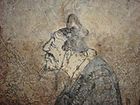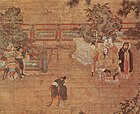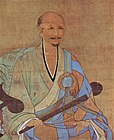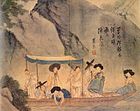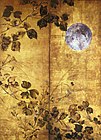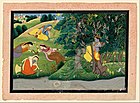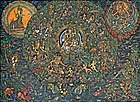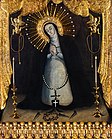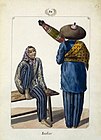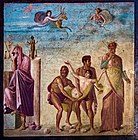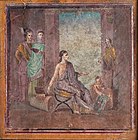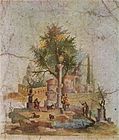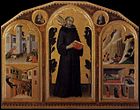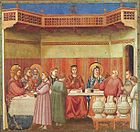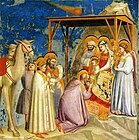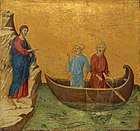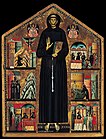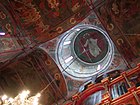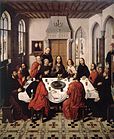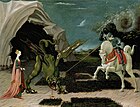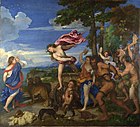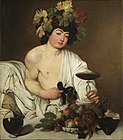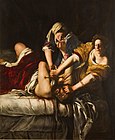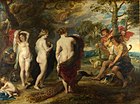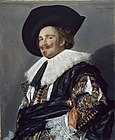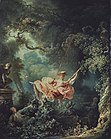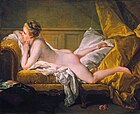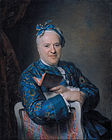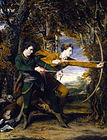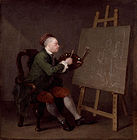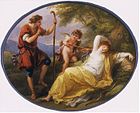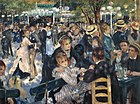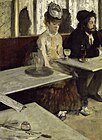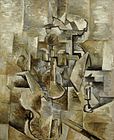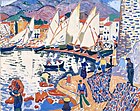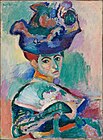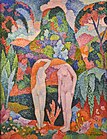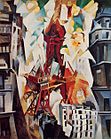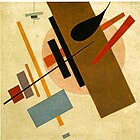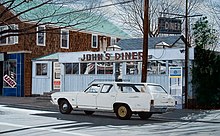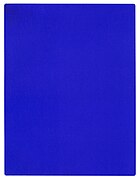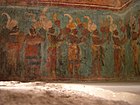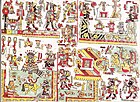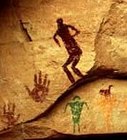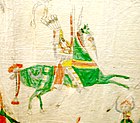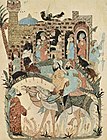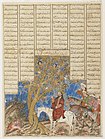History of painting
This article has multiple issues. Please help improve it or discuss these issues on the talk page. (Learn how and when to remove these template messages)
|
| History of art |
|---|
The history of painting reaches back in time to artifacts and artwork created by pre-historic artists, and spans all cultures. It represents a continuous, though periodically disrupted, tradition from Antiquity. Across cultures, continents, and millennia, the history of painting consists of an ongoing river of creativity that continues into the 21st century.
Developments in Eastern painting historically parallel those in Western painting, in general, a few centuries earlier.[2] African art, Jewish art, Islamic art, Indonesian art, Indian art,[3] Chinese art, and Japanese art[4] each had significant influence on Western art, and vice versa.[5]
Initially serving utilitarian purpose, followed by imperial, private, civic, and religious patronage, Eastern and Western painting later found audiences in the
Pre-history

The oldest known paintings are approximately 40,000 years old, found in both the
Various conjectures have been made as to the meaning these paintings had to the people that made them. Prehistoric artists may have painted animals to "catch" their
-
rock painting, Stone Age, India
-
Lascaux, Horse
-
rock painting, Drakensberg, South Africa
-
Lascaux, Bulls and Horses
-
Spanish cave painting of Bulls
-
Petroglyphs, from Sweden, Nordic Bronze Age(painted)
-
Horseshoe Canyon, Utah, c. 1500 BCE
-
Cueva de las Manos (Spanish for Cave of the Hands) in the Santa Cruz province in Argentina, c. 7300 BC
-
Kimberley region of Western Australia c. 15,000 BC[17]
In
If there is meaning to the paintings, it remains unknown. The caves were not in an inhabited area, so they may have been used for seasonal rituals. The animals are accompanied by signs which suggest a possible magic use. Arrow-like symbols in Lascaux are sometimes interpreted as being used as calendars or almanacs, but the evidence remains inconclusive.[18] The most important work of the Mesolithic era were the marching warriors, a rock painting at Cingle de la Mola, Castellón, Spain dated to about 7000 to 4000 BC. The technique used was probably spitting or blowing the pigments onto the rock. The paintings are quite naturalistic, though stylized. The figures are not three-dimensional, even though they overlap.
The earliest known Indian paintings were the rock paintings of
Eastern
The history of Eastern painting includes a vast range of influences from various cultures and religions. Developments in
East Asian
See also Chinese painting, Japanese painting, Korean painting.
This section contains an unencyclopedic or excessive gallery of images. |
-
AState of Chu (704–223 BC), depicting men riding in a two-horsed chariot
-
Detail of a fresco showing the Chinese philosopherShandong province
-
A Chinese woman, fresco from aShaanxi province
-
Paintings on tile of guardian spirits donned inChinese robes, from the Han dynasty(202 BC – 220 AD)
-
Gentlemen in Conversation, tomb painting dated to theEastern Han dynasty(25–220 AD).
-
Eastern Han dynasty(25-220 AD)
-
Female court attendants, a mural from anHenan province
-
Female court attendants, a mural from anHenan province
-
Male figure from a lacquerware painting over wood, Northern Wei period, 5th century AD
-
Northern Wei dynasty(386-535 AD)
-
Eighty-Seven Celestials, by Wu Daozi (685–758), Tang dynasty, Chinese
-
Portrait of Night-Shining White, by Han Gan, 8th century, Tang dynasty, Chinese
-
Spring Outing of the Tang Court, by Zhang Xuan, 8th century, Tang dynasty, Chinese
-
Servant, 8th century, Tang dynasty, Chinese
-
Ladies making silk, a remake of an 8th-century original by Zhang Xuan by Emperor Huizong of Song, early 12th century, Chinese
-
An illustrated sutra from the Nara period, 8th century, Japanese
-
Ladies Playing Double Sixes, by Zhou Fang (730–800 AD), Tang dynasty, Chinese
-
A Palace Concert, Tang dynasty, Chinese
-
The Xiao and Xiang Rivers, by Dong Yuan (c. 934–962 AD), Chinese
-
Night Revels, a Song dynasty remake of a 10th-century original by Gu Hongzhong.
-
Court portrait of Emperor Shenzong of Song (r. 1067–1085), Chinese
-
Golden Pheasant and Cotton Rose, by Emperor Huizong of Song (r.1100–1126 AD), Chinese
-
Listening to the Guqin, by Emperor Huizong of Song (1100–1126 AD), Chinese
-
Children Playing, by Su Han Chen, c. 1150, Chinese
-
Chinese, anonymous artist of the 12th century Song dynasty
-
Portrait of the Zen Buddhist Wuzhun Shifan, 1238 AD, Chinese
-
Ma Lin, 1246 AD, Chinese
-
A Man and His Horse in the Wind, by Zhao Mengfu (1254–1322 AD), Chinese
-
Shukei-sansui (Autumn Landscape),Sesshu Toyo(1420–1506), Japanese
-
Kanō Masanobu, 15th-century founder of the Kanō school, Zhou Maoshu Appreciating Lotuses, Japanese
-
A White-Robed Kannon, Bodhisattva of Compassion, by Kanō Motonobu (1476–1559), Japanese
-
Yi Ahm (1499–?), Mother Dog, 15th century, National Museum of Korea
-
Tang Yin, A Fisher in Autumn, (1523), Chinese
-
Nanban ships arriving for trade in Japan, 16th century, Japanese
-
A screen painting depicting people playing Go, by Kanō Eitoku (1543–1590), Japanese
-
Right panel of the Pine Trees screen (Shōrin-zu byōbu, 松林図 屏風) by Hasegawa Tōhaku (1539–1610), Japanese
-
Scroll calligraphy of Bodhidharma, "Zen points directly to the human heart, see into your nature and become Buddha", Hakuin Ekaku (1686 to 1769), Japanese
-
Hanging scroll 1672,Kanō Tanyū(1602–1674), Japanese
-
Peonies, by Yun Shouping (1633–1690), Chinese
-
Genji Monogatari, by Tosa Mitsuoki (1617–1691), Japanese
-
View of Geumgang, Jeong Seon (1676–1759), 1734, Korean
-
Ike no Taiga (1723–1776), Fish in Spring, Japanese
-
Maruyama school, Pine, Bamboo, Plum, six-fold screen, Maruyama Ōkyo(1733–1795), Japanese
-
A Cat and a Butterfly, Kim Hong-do (1745–?), 18th century, Korean
-
A Boat Ride,Shin Yun-bok(1758–?), 1805, Korean
-
Sakai Hoitsu(1761–1828), Japanese
-
A tanuki (raccoon dog) as a tea kettle, byKatsushika Hokusai(1760–1849), Japanese
-
A House amongst Apricot Trees, Jo Hee-ryong (1797–1859), Korean
-
Katsushika Hokusai, The Dragon of Smoke Escaping from Mt Fuji, Japanese
-
Miyagawa Isshō, untitled Ukiyo-e painting, Japanese
-
Tomioka Tessai (1837–1924), Nihonga style, Two Divinities Dancing, 1924, Japanese
China, Japan and Korea have a strong tradition in painting which is also highly attached to the art of calligraphy and printmaking (so much that it is commonly seen as painting). Far east traditional painting is characterized by water based techniques, less realism, "elegant" and stylized subjects, graphical approach to depiction, the importance of white space (or negative space) and a preference for landscape (instead of the human figure) as a subject. Beyond ink and color on silk or paper scrolls, gold on lacquer was also a common medium in painted East Asian artwork. Although silk was a somewhat expensive medium to paint upon in the past, the invention of paper during the 1st century AD by the Han court eunuch Cai Lun provided not only a cheap and widespread medium for writing, but also a cheap and widespread medium for painting (making it more accessible to the public).
The ideologies of
In
Chinese

The earliest surviving examples of Chinese painted artwork date to the
The establishment of classical Chinese landscape painting is accredited largely to the
During the Chinese
...Then there was Li Cheng, who when he depicted
eaves as seen from below. His idea was that 'one should look upwards from underneath, just as a man standing on level ground and looking up at the eaves of a pagoda can see its rafters and its cantilever eave rafters'. This is all wrong. In general the proper way of painting a landscape is to see the small from the viewpoint of the large...just as one looks at artificial mountains in gardens (as one walks about). If one applies (Li's method) to the painting of real mountains, looking up at them from below, one can only see one profile at a time, and not the wealth of their multitudinous slopes and profiles, to say nothing of all that is going on in the valleys and canyons, and in the lanes and courtyards with their dwellings and houses. If we stand to the east of a mountain its western parts would be on the vanishing boundary of far-off distance, and vice versa. Surely this could not be called a successful painting? Mr. Li did not understand the principle of 'seeing the small from the viewpoint of the large'. He was certainly marvelous at diminishing accurately heights and distances, but should one attach such importance to the angles and corners of buildings?[24]
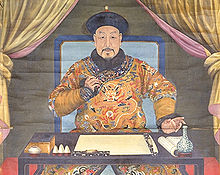
Although high level of stylization, mystical appeal, and surreal elegance were often preferred over realism (such as in shan shui style), beginning with the medieval Song dynasty there were many Chinese painters then and afterwards who depicted scenes of nature that were vividly real. Later Ming dynasty artists would take after this Song dynasty emphasis for intricate detail and realism on objects in nature, especially in depictions of animals (such as ducks, swans, sparrows, tigers, etc.) amongst patches of brightly colored flowers and thickets of brush and wood (a good example would be the anonymous Ming dynasty painting Birds and Plum Blossoms,[25] housed in the Freer Gallery of the Smithsonian Museum in Washington, D.C.). There were many renowned Ming dynasty artists; Qiu Ying is an excellent example of a paramount Ming era painter (famous even in his own day), utilizing in his artwork domestic scenes, bustling palatial scenes, and nature scenes of river valleys and steeped mountains shrouded in mist and swirling clouds. During the Ming dynasty there were also different and rivaling schools of art associated with painting, such as the Wu School and the Zhe School.
Classical Chinese painting continued on into the early modern Qing dynasty, with highly realistic portrait paintings like seen in the late Ming dynasty of the early 17th century. The portraits of Kangxi Emperor, Yongzheng Emperor, and Qianlong Emperor are excellent examples of realistic Chinese portrait painting. During the Qianlong reign period and the continuing 19th century, European Baroque styles of painting had noticeable influence on Chinese portrait paintings, especially with painted visual effects of lighting and shading. Likewise, East Asian paintings and other works of art (such as porcelain and lacquerware) were highly prized in Europe since initial contact in the 16th century.
Chinese oil paintings
Western techniques of oil paintings began entering China in the 19th century, becoming prevalent among Chinese artists and art students in the early 20th century, coinciding with China's growing engagement with the West. Artists such as Li Tiefu, Hong Yi, Xu Beihong, Yan Wenliang, Lin Fengmian, Fang Ganmin, Pang Yuliang went abroad, predominantly to Paris and Tokyo, to learn Western art. Through them, artistic movements such as Impressionism, Cubism, Fauvism, Post-impressionism grew and thrived in China, only halted by the Second World War and the birth of the People's Republic of China, when modernistic artistic styles were seen as being inconsistent with the prevailing political ideals and realism was the only acceptable artistic form. Nonetheless, the legacy of the close engagement with Western art in the early 20th century endured. Oil paintings survived as an important medium in Chinese artistic scenes; traditional Chinese ink paintings were also changed as a result.
-
Portrait of Madame Liu, (1942) Li Tiefu oil on canvas
-
Portrait of Kang Youwei (1904) Li Tiefu oil on canvas
-
Portrait of Madam Cheng (1941) Oil on board Xu Beihong
Japanese

Japanese painting (絵画) is one of the oldest and most highly refined of the Japanese arts, encompassing a wide variety of genres and styles. As with Japanese arts in general, Japanese painting developed through a long history of synthesis and competition between native Japanese
Korean
Korean painting, as an independent form, began around 108 B.C., around the fall of
The history of Korean painting has been characterized by the use monochromatic works of black brushwork, often on mulberry paper or silk. This style is evident in "Min-Hwa", or colorful folk art, tomb paintings, and ritual and festival arts, both of which incorporated an extensive use of colour.
South Asian
-
Floating Figures Dancing, a mural of c. 850.
-
Deccan painting; the young Ibrahim Adil Shah II hawking, c. 1590
-
Mughal, Yudishthira wrestling with Karna, 1598
-
Emperor Shah Jahan and sons, c. 1628 or later. Mughal portraits normally use profile views.
-
A Lady Listening to Music, c. 1750.
-
Bahsoli painting of Radha and Krishna in Discussion, c. 1730.
-
Deccan painting, Sultan Ibrahim Adil Shah II of Bijapur, c. 1590. A three-quarter view which gives a powerful and lively impression of the sitter, despite lacking both Mughal precision, and very coherent modelling of the surfaces.
-
Mughal portrait of Raja Jagat Singh of Nurpur (reigned 1618–1646), probably 1619
-
Pahari painting, Chamba, c. 1665, a warrior mounts his horse
-
Portrait of the Govardhân Chand, Pahari painting style, c. 1750.
-
Ravana kills Jathayu; the captive Sita despairs, by Raja Ravi Varma
-
Akbar and Tansen Visit Haridas in Vrindavan, Rajasthan style, c. 1750.
-
Krishna Summoning the Cows,Bilaspur, 18th century
-
A man with children, Pahari painting style, 1760.
-
Company style, 1770s, Crimson Horned Pheasant (Satyr Tragapan)
-
Râdhâ arrests Krishna, Pahari painting style, 1770.
-
Rama and Sita in the Forest, Pahari painting style, 1780.
-
Late Rajput painting, Kota, c. 1830s, Ram Singh II Tiger Hunting
Indian
Indian paintings historically revolved around the religious deities and kings. Indian art is a collective term for several different schools of art that existed in the
History
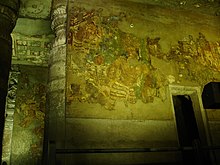
The earliest Indian paintings were the rock paintings of
- Madhubani painting
Mughal

Mughal painting is a particular style of Indian painting, generally confined to illustrations on the book and done in miniatures, and which emerged, developed and took shape during the period of the Mughal Empire 16th −19th centuries.
Rajput
Rajput painting evolved and flourished during the 18th century, in the royal courts of Rajputana, India. Each Rajput kingdom evolved a distinct style, but with certain common features. Rajput paintings depict a number of themes, events of epics like the Ramayana and the Mahabharata, Krishna's life, beautiful landscapes, and humans. Miniatures were the preferred medium of Rajput painting, but several manuscripts also contain Rajput paintings, and paintings were even done on the walls of palaces, inner chambers of the forts, havelies, particularly, the havelis of Shekhawait.
The colors extracted from certain minerals, plant sources, conch shells, and were even derived by processing precious stones, gold and silver were used. The preparation of desired colors was a lengthy process, sometimes taking weeks. Brushes used were very fine.
Tanjore
The process of making a Tanjore painting involves many stages. The first stage involves the making of the preliminary sketch of the image on the base. The base consists of a cloth pasted over a wooden base. Then chalk powder or
Madras School
During British rule in India, the crown found that Madras had some of the most talented and intellectual artistic minds in the world. As the British had also established a huge settlement in and around Madras, Georgetown was chosen to establish an institute that would cater to the artistic expectations of the royal family in London. This has come to be known as the
Unlike the Bengal School where 'copying' is the norm of teaching, the Madras School flourishes on 'creating' new styles, arguments and trends.
Bengal School
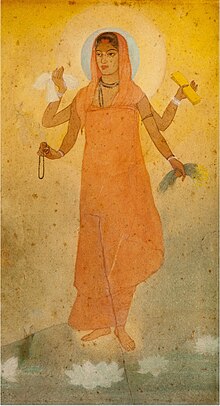
The
The Bengal School arose as an
The Bengal School's influence in India declined with the spread of
Modern Indian
Amrita Sher-Gil was an Indian painter, sometimes known as India's Frida Kahlo,[29] and today considered an important woman painter of 20th-century India, whose legacy stands at par with that of the Masters of Bengal Renaissance;[30][31] she is also the 'most expensive' woman painter of India.[32]
Today, she is amongst Nine Masters, whose work was declared as art treasures by The Archaeological Survey of India, in 1976 and 1979,[33] and over 100 of her paintings are now displayed at National Gallery of Modern Art, New Delhi.[34]
During the colonial era, Western influences started to make an impact on Indian art. Some artists developed a style that used Western ideas of composition, perspective and realism to illustrate Indian themes. Others, like Jamini Roy, consciously drew inspiration from folk art.
By the time of Independence in 1947, several schools of art in India provided access to modern techniques and ideas. Galleries were established to showcase these artists. Modern Indian art typically shows the influence of Western styles, but is often inspired by Indian themes and images. Major artists are beginning to gain international recognition, initially among the Indian diaspora, but also among non-Indian audiences.
The
Indian art got a boost with the
South-East Asia
Indonesian

The oldest known
The discovery of the then-oldest known figurative art painting, over 40,000 (perhaps as old as 52,000) years old, of an unknown animal, in the cave of Lubang Jeriji Saléh on the Indonesian island of Borneo. In December 2019, however, figurative cave paintings depicting pig hunting in the Maros-Pangkep karst in Sulawesi were estimated to be even older, at at least 43,900 years old. The finding was noted to be "the oldest pictorial record of storytelling and the earliest figurative artwork in the world".[14][15]

Other examples of Indonesian paintings are the Kenyah decorative art, based on endemic natural motifs such as ferns and hornbills, found decorating the walls of Kenyah longhouses. Other notable traditional art is the geometric Toraja wood carvings. Balinese paintings are initially the narrative images to depict scenes of Balinese legends and religious scripts. The classical Balinese paintings are often decorating the lontar manuscripts and also the ceilings of temples pavilion. Notable modern Indonesian painters in the European tradition include Raden Saleh, Jan Toorop, Basuki Abdullah and Abdullah Suriosubroto, their themes explore landscape and portrait painting.
-
Traditional Balinese painting depictingcockfighting.
-
Capture of Prince Diponegoro, 1857.
-
Javanese Landscape, with Tigers Listening to the Sound of a Travelling Group, 1849.
-
The Wheel of Life, I Ketut Murtika (b. 1952), Gouache on canvas
-
Pre-1920 Kamasan Palindon Painting detail, an example of Kamasan-style classical painting.
-
Mask Dancer (by A.A. Gde Anom Sukawati) in Puri Lukisan Museum.
-
Legong dancer.
-
Indonesian Temple painting.
Filipino

Filipino painting as a whole can be seen as an amalgamation of many cultural influences, though it tends to be more Western in its current form with Eastern roots.
Early Filipino painting can be found in red slip (clay mixed with water) designs embellished on the ritual pottery of the Philippines such as the
carved and painted in the beautiful Panolong of their Torogan or King's House.
Filipinos began creating paintings in the European tradition during the 17th-century Spanish period.[36] The earliest of these paintings were Church frescoes and religious imagery from Biblical sources as well as engravings, sculptures and lithographs featuring Christian icons and European nobility. Most of the paintings and sculptures between the 19th and 20th century were a mixture of religious, political, and landscape artwork, with qualities of sweetness, dark, and light. Early modernist painters such as Damián Domingo were associated with religious and secular paintings. The art of Juan Luna and Félix Hidalgo showed a trend toward political statement. Artists such as Fernando Amorsolo used post-modernism to produce paintings that illustrated Philippine culture, nature, and harmony. Other artists such as Fernando Zóbel used reality and abstraction in their work.
-
Lila Church ceiling painting
-
Lorenzo de la Rocha Icaza, Mujer filipina, 1895
-
Fabián de la Rosa, Women Working in rice field, 1902
-
José Honorato Lozano, Indios, 1847
Western
Egypt, Greece and Rome

-
Sennedjem plows his fields with a pair of oxen, c. 1200 BC
-
Ancient Egypt, Queen Nefertari
-
Ancient Egypt, papyrus
-
Mural ofAncient Macedonia, 4th century BC
-
Fresco of an ancientthureosshield, 3rd century BC
-
Fresco depicting sacrifice of Iphigenia
-
Roman art showing Dirce's punishment
-
Roman art showing Pirithous and Hippodamia
-
Roman art, Pompeii, Villa of the Mysteries, c. 60-50 BC
-
Roman art, Villa Boscoreale frescos, c. 40 BC
-
Roman art, Pompeii
-
The Three Graces, fresco from Pompeii
-
The Fall of Icarus, fresco from Pompeii, 40-79 AD
-
Roman art, Pompeii
-
Roman art, Fayum mummy portraits from Roman Egypt
-
Roman art from the House of the Vettii, Pompeii, 1st century AD
-
Roman fresco with a seated Venus, the so-called "Dea Barberini", 4th century AD
To the north of
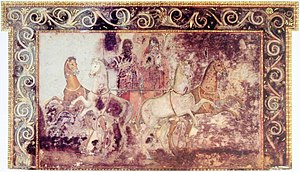
Middle Ages
-
Byzantine icon, 6th century
-
Byzantine art mosaics in Ravenna
-
Byzantine, 6th century
-
Limbourg Brothers
-
Limbourg Brothers
-
Book of Hours
-
The Capture of Jerusalem during the First Crusade, c. 1099
-
The Morgan Leaf, from the Winchester Bible 1160–75, Scenes from the life of David
-
Yaroslavl Gospels c. 1220s
-
Carolingian
-
CarolingianSaint Mark
-
Giotto
-
Giotto
-
Giotto
-
Duccio
-
Bonaventura Berlinghieri, St Francis of Assisi, 1235
-
Chora Church
-
Rogier van der Weyden, (c. 1435)
-
Rogier van der Weyden, St Ivo (c. 1450)
-
Voronet Monastery
The rise of Christianity imparted a different spirit and aim to painting styles. Byzantine art, once its style was established by the 6th century, placed great emphasis on retaining traditional iconography and style, and gradually evolved during the thousand years of the Byzantine Empire and the living traditions of Greek and Russian Orthodox icon-painting. Byzantine painting has a hieratic feeling and icons were and still are seen as a representation of divine revelation. There were many frescos, but fewer of these have survived than mosaics. Byzantine art has been compared to contemporary
In post-Antique Catholic Europe the first distinctive artistic style to emerge that included painting was the Insular art of the British Isles, where the only surviving examples are miniatures in Illuminated manuscripts such as the Book of Kells.[39] These are most famous for their abstract decoration, although figures, and sometimes scenes, were also depicted, especially in Evangelist portraits. Carolingian and Ottonian art also survives mostly in manuscripts, although some wall-painting remain, and more are documented. The art of this period combines Insular and "barbarian" influences with a strong Byzantine influence and an aspiration to recover classical monumentality and poise.
Walls of Romanesque and Gothic churches were decorated with frescoes as well as sculpture and many of the few remaining murals have great intensity, and combine the decorative energy of Insular art with a new monumentality in the treatment of figures. Far more miniatures in Illuminated manuscripts survive from the period, showing the same characteristics, which continue into the Gothic period.
Panel painting becomes more common during the
Churches were built with more and more windows and the use of colorful
Renaissance and Mannerism
-
Robert Campin, c. 1425
-
Jan van Eyck, 1434
-
Rogier van der Weyden, c. 1435
-
Hugo van der Goes, c. 1470
-
Dieric Bouts, 1464–1467
-
Hans Memling, c. 1466–1473
-
Petrus Christus, c. 1470
-
Hieronymus Bosch, c. 1480–1505
-
Fra Angelico, 1425–1428
-
Paolo Uccello, c. 1470
-
Masaccio, 1426–1427
-
Jean Fouquet, 1450
-
Andrea Mantegna, c. 1458–1460
-
Piero della Francesca, 1463–1465
-
Sandro Botticelli, 1483–1485
-
Leonardo da Vinci, 1503–1506
-
Raphael, 1505–1506
-
Michelangelo, c. 1511
-
Lucas Cranach the Elder, c. 1530
-
Albrecht Dürer, 1500
-
Matthias Grünewald, 1512–1516
-
Giovanni Bellini, c. 1480
-
Giorgione, c. 1505
-
Titian, 1520–1523
-
École de Fontainebleau, 1530
-
Bronzino, 1540–1545
-
Pieter Bruegel, 1565
-
Hans Holbein the Younger, 1527
-
Jacopo Tintoretto, 1582
-
Paolo Veronese, 1562–1563
-
Joachim Wtewael, 1595
-
El Greco, 1596–1600
The Renaissance (French for 'rebirth'), a cultural movement roughly spanning the 14th through the mid-17th century, heralded the study of classical sources, as well as advances in science which profoundly influenced European intellectual and artistic life. In the
In Italy, the art of
, were less concerned with precision in their drawing than with the richness of color and unity of effect that could be achieved by a more spontaneous approach to painting.Flemish, Dutch and German painters of the Renaissance such as Hans Holbein the Younger, Albrecht Dürer, Lucas Cranach, Matthias Grünewald, Hieronymus Bosch, and Pieter Bruegel represent a different approach from their Italian colleagues, one that is more realistic and less idealized. Genre painting became a popular idiom amongst the Northern painters like Pieter Bruegel.
The French tradition of
Renaissance painting reflects the revolution of ideas and science (
The High Renaissance gave rise to a stylized art known as Mannerism. In place of the balanced compositions and rational approach to perspective that characterized art at the dawn of the 16th century, the Mannerists sought instability, artifice, and doubt. The unperturbed faces and gestures of Piero della Francesca and the calm Virgins of Raphael are replaced by the troubled expressions of Pontormo and the emotional intensity of El Greco. Restless and unstable compositions, often extreme or disjunctive effects of perspective, and stylized poses are characteristic of Italian Mannerists such as Tintoretto, Pontormo, and Bronzino, and appeared later in the work of Northern Mannerists such as Hendrick Goltzius, Bartholomeus Spranger, and Joachim Wtewael.
Baroque and Rococo
-
Caravaggio, 1595–1597
-
Artemisia Gentileschi, 1614–1620
-
Peter Paul Rubens, 1632–1635
-
Frans Hals, 1624
-
Judith Leyster, 1630
-
Rembrandt van Rijn, 1642
-
Pieter de Hooch, 1658
-
Johannes Vermeer, c. 1660
-
Jan Steen, c. 1665
-
Jacob van Ruisdael, 1670
-
Willem Claesz. Heda, 1631
-
Diego Velázquez, 1656–1657
-
Jusepe de Ribera, 1620–1624
-
Nicolas Poussin, c. 1637–1638
-
Georges de La Tour, 1640s
-
Guido Reni, 1625
-
Salvator Rosa, c. 1645
-
Bartolomé Esteban Murillo, c. 1650–1655
-
Claude Lorrain, 1648
-
Anthony van Dyck, 1635–1636
-
Canaletto, 1723
-
Giovanni Battista Tiepolo, c. 1752–1753
-
Antoine Watteau, c. 1720
-
Jean-Honoré Fragonard, c. 1767–1768
-
François Boucher, 1751
-
Élisabeth Louise Vigée-Le Brun, after 1782
-
Maurice Quentin de La Tour, c. 1761
-
Thomas Gainsborough, c. 1770
-
Joshua Reynolds, 1769
-
Jean-Baptiste-Siméon Chardin, c. 1728
-
William Hogarth, c. 1757
-
Angelica Kauffman, c. 1780
Baroque painting is associated with the
Baroque painting is characterized by great drama, rich, deep color, and intense light and dark shadows. Baroque art was meant to evoke emotion and passion instead of the calm rationality that had been prized during the Renaissance. During the period beginning around 1600 and continuing throughout the 17th century, painting is characterized as Baroque. Among the greatest painters of the Baroque are
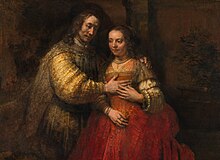
In Italy, the Baroque style is epitomized by religious and mythological paintings in the
During the 18th century,
The Rococo style spread with French artists and engraved publications. It was readily received in the Catholic parts of Germany,
The French masters
William Hogarth helped develop a theoretical foundation for Rococo beauty. Though not intentionally referencing the movement, he argued in his Analysis of Beauty (1753) that the undulating lines and S-curves prominent in Rococo were the basis for grace and beauty in art or nature (unlike the straight line or the circle in Classicism). The beginning of the end for Rococo came in the early 1760s as figures like Voltaire and Jacques-François Blondel began to voice their criticism of the superficiality and degeneracy of the art. Blondel decried the "ridiculous jumble of shells, dragons, reeds, palm-trees and plants" in contemporary interiors.[45]
By 1785, Rococo had passed out of fashion in France, replaced by the order and seriousness of Neoclassical artists like Jacques-Louis David.
19th century: Neo-classicism, History painting, Romanticism, Impressionism, Post-Impressionism, Symbolism
-
Jacques-Louis David 1787
-
John Constable 1802
-
Antoine-Jean Gros, 1804
-
Jean Auguste Dominique Ingres1814
-
Francisco de Goya1814
-
Théodore Géricault 1819
-
Caspar David Friedrich c.1822
-
Eugène Delacroix 1830
-
J. M. W. Turner 1838
-
Gustave Courbet 1849–1850
-
Ivan Aivazovsky 1850
-
Albert Bierstadt 1866
-
Camille Corot c.1867
-
Ilya Repin 1870–1873
-
Camille Pissarro 1872
-
Claude Monet 1872
-
Edgar Degas 1876
-
Édouard Manet 1882
-
Thomas Eakins 1884–1885
-
Georges Seurat 1884–1886
-
Valentin Serov 1887
-
Vincent van Gogh 1889
-
Albert Pinkham Ryder 1890
-
Paul Gauguin 1897–1898
-
Winslow Homer 1899
-
Paul Cézanne 1906
After
By the mid-19th-century painters became liberated from the demands of their patronage to only depict scenes from religion, mythology, portraiture or history. The idea "art for art's sake" began to find expression in the work of painters like Francisco de Goya, John Constable, and J.M.W. Turner. Romantic painters saw landscape painting as an important genre to express the vanity of mankind in opposition to the grandeur of nature. Until then, landscape painting wasn't considered the most important genre for painters (like portraiture or history painting). But painters like J.M.W. Turner and Caspar David Friedrich managed to elevate landscape painting to an eminence rivalling history painting. Some of the major painters of this period are

The leading
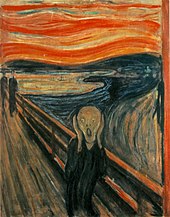
Pissarro adopted some of the experiments of Post-Impressionism. Slightly younger Post-Impressionists like Vincent van Gogh, Paul Gauguin, and Georges Seurat, along with Paul Cézanne led art to the edge of modernism; for Gauguin Impressionism gave way to a personal symbolism; Seurat transformed Impressionism's broken color into a scientific optical study, structured on frieze-like compositions; Van Gogh's turbulent method of paint application, coupled with a sonorous use of color, predicted Expressionism and Fauvism, and Cézanne, desiring to unite classical composition with a revolutionary abstraction of natural forms, would come to be seen as a precursor of 20th-century art. The spell of Impressionism was felt throughout the world, including in the United States, where it became integral to the painting of
In the late 19th century there also were several, rather dissimilar, groups of
20th-century modern and contemporary
The heritage of painters like
Pioneers of the 20th century
-
Henri Matisse 1905, Fauvism
-
Pablo Picasso 1907, Proto-Cubism
-
Analytic Cubism

The heritage of painters like
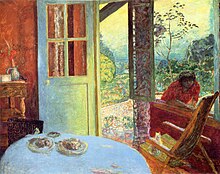
Les Fauves (French for The Wild Beasts) were early-20th-century painters, experimenting with freedom of expression through color. The name was given, humorously and not as a compliment, to the group by art critic
How do you see these trees? They are yellow. So, put in yellow; this shadow, rather blue, paint it with pure ultramarine; these red leaves? Put in vermilion.
The leaders of the movement were

Fauvism, as a movement, had no concrete theories, and was short lived, beginning in 1905 and ending in 1907, they only had three exhibitions. Matisse was seen as the leader of the movement, due to his seniority in age and prior self-establishment in the academic art world. His 1905 portrait of Mme. Matisse The Green Line, (above), caused a sensation in Paris when it was first exhibited. He said he wanted to create art to delight; art as a decoration was his purpose and it can be said that his use of bright colors tries to maintain serenity of composition. In 1906 at the suggestion of his dealer
continued developing their narrative styles independent of any movement throughout the 20th century.By 1907 Fauvism no longer was a shocking new movement, soon it was replaced by
During the years between 1910 and the end of World War I and after the heyday of
Pioneers of Modern art
-
André Derain, 1905, Le séchage des voiles (The Drying Sails), Fauvism
-
Henri Matisse, 1905, Woman with a Hat, Fauvism
-
Edvard Munch, Death of Marat I (1907), an example of Expressionism
-
Gustav Klimt, expressionism, 1907–1908
-
Pablo Picasso, 1908, Dryad, Proto-Cubism
-
l'Homme au Balcon, Man on a Balcony (Portrait of Dr. Théo Morinaud), Cubism
-
Danseuse au café (Dancer in a café), Cubism
-
Franz Marc 1912, Der Blaue Reiter
-
Robert Delaunay, 1911, Orphism
-
Wassily Kandinsky 1913, birth of abstract art
-
Soutine 1916, example of Expressionism
-
synthetic Cubism, tubism
In the first two decades of the 20th century and after
Other major pioneers of early abstraction include Russian painter
Expressionism and Symbolism are broad rubrics that involve several important and related movements in 20th-century painting that dominated much of the avant-garde art being made in Western, Eastern and Northern Europe. Expressionist works were painted largely between World War I and World War II, mostly in France, Germany, Norway, Russia, Belgium, and Austria. Expressionist artists are related to both Surrealism and Symbolism and are each uniquely and somewhat eccentrically personal. Fauvism, Die Brücke, and Der Blaue Reiter are three of the best known groups of Expressionist and Symbolist painters.
Artists as interesting and diverse as
Pioneers of abstraction
-
Piet Mondrian, 1912, early De Stijl
-
Kasimir Malevich 1916, Suprematism
-
Neo-Plasticism
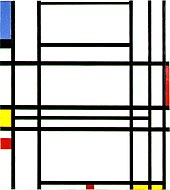
De Stijl also known as neoplasticism, was a Dutch artistic movement founded in 1917. The term De Stijl is used to refer to a body of work from 1917 to 1931 founded in the Netherlands.[52][53]
De Stijl is also the name of a journal that was published by the Dutch painter, designer, writer, and critic Theo van Doesburg propagating the group's theories. Next to van Doesburg, the group's principal members were the painters Piet Mondrian, Vilmos Huszár, and Bart van der Leck, and the architects Gerrit Rietveld, Robert van 't Hoff, and J. J. P. Oud. The artistic philosophy that formed a basis for the group's work is known as neoplasticism – the new plastic art (or Nieuwe Beelding in Dutch).

Proponents of De Stijl sought to express a new
De Stijl movement was influenced by
Dada and Surrealism
-
Francis Picabia 1916, Dada
-
Max Ernst, 1921, Surrealism
-
André Masson, 1922, early Surrealism



In 1924
were very influential, especially in the United States during the 1940s. Throughout the 1930s, Surrealism continued to become more visible to the public at large. A Surrealist group developed in Britain and, according to Breton, their 1936 London International Surrealist Exhibition was a high water mark of the period and became the model for international exhibitions. Surrealist groups in Japan, and especially in Latin America, the Caribbean and in Mexico produced innovative and original works.Dalí and Magritte created some of the most widely recognized images of the movement. The 1928/1929 painting This Is Not A Pipe, by Magritte is the subject of a Michel Foucault 1973 book, This is not a Pipe (English edition, 1991), that discusses the painting and its paradox. Dalí joined the group in 1929, and participated in the rapid establishment of the visual style between 1930 and 1935.
Surrealism as a visual movement had found a method: to expose psychological truth by stripping ordinary objects of their normal significance, in order to create a compelling image that was beyond ordinary formal organization, and perception, sometimes evoking empathy from the viewer, sometimes laughter and sometimes outrage and bewilderment.
1931 marked a year when several Surrealist painters produced works which marked turning points in their stylistic evolution: in one example, liquid shapes become the trademark of Dalí, particularly in his The Persistence of Memory, which features the image of watches that sag as if they are melting. Evocations of time and its compelling mystery and absurdity.[57]
The characteristics of this style – a combination of the depictive, the abstract, and the psychological – came to stand for the alienation which many people felt in the modernist period, combined with the sense of reaching more deeply into the psyche, to be "made whole with one's individuality."

Max Ernst whose 1920 painting Murdering Airplane, studied philosophy and psychology in Bonn and was interested in the alternative realities experienced by the insane. His paintings may have been inspired by the
During the 1920s
Long after personal, political and professional tensions have fragmented the Surrealist group into thin air and ether, Magritte, Miró, Dalí and the other Surrealists continue to define a visual program in the arts. Other prominent surrealist artists include Giorgio de Chirico, Méret Oppenheim, Toyen, Grégoire Michonze, Roberto Matta, Kay Sage, Leonora Carrington, Dorothea Tanning, and Leonor Fini among others.
Before and after the war
-
Ernst Kirchner, Die Brücke1913
-
American Modernism, 1921
-
Stuart Davis, American Modernism 1922
-
Chaïm Soutine, Expressionism, c. 1920

Wassily Kandinsky, Franz Marc, August Macke, Alexej von Jawlensky, whose psychically expressive painting of the Russian dancer Portrait of Alexander Sakharoff, 1909 is in the gallery above, Marianne von Werefkin, Lyonel Feininger and others founded the Der Blaue Reiter group in response to the rejection of Kandinsky's painting Last Judgement from an exhibition. Der Blaue Reiter lacked a central artistic manifesto, but was centered around Kandinsky and Marc. Artists Gabriele Münter and Paul Klee were also involved.

The name of the movement comes from a painting by Kandinsky created in 1903. It is also claimed that the name could have derived from Marc's enthusiasm for horses and Kandinsky's love of the colour blue. For Kandinsky, blue is the colour of spirituality: the darker the blue, the more it awakens human desire for the eternal.
In the USA during the period between World War I and World War II painters tended to go to Europe for recognition. Artists like
Social consciousness
-
Neue Sachlichkeit
-
Regionalism
-
American realism
-
Pop Art)
During the 1920s and the 1930s and the
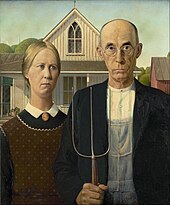
Diego Rivera is perhaps best known by the public world for his 1933 mural, "
Political activism was an important piece of
World conflict
-
German Expressionism
-
Wassily Kandinsky Composition X 1939, Geometric abstraction
During the 1930s radical leftist politics characterized many of the artists connected to
In its final form, Guernica is an immense black and white, 3.5 metres (11 feet) tall and 7.8 metres (26 feet) wide mural painted in oil. The mural presents a scene of death, violence, brutality, suffering, and helplessness without portraying their immediate causes. The choice to paint in black and white contrasts with the intensity of the scene depicted and invokes the immediacy of a newspaper photograph.[62]
Picasso painted the mural sized painting called
During the
The Dynamic for artists in Europe during the 1930s deteriorated rapidly as the Nazi's power in Germany and across Eastern Europe increased. The climate became so hostile for artists and art associated with
Degenerate Art was also the title of an exhibition, mounted by the Nazis in Munich in 1937, consisting of modernist artworks chaotically hung and accompanied by text labels deriding the art. Designed to inflame public opinion against modernism, the exhibition subsequently traveled to several other cities in Germany and Austria. German artist Max Beckmann and scores of others fled Europe for New York. In New York City a new generation of young and exciting Modernist painters led by Arshile Gorky, Willem de Kooning, and others were just beginning to come of age.
Arshile Gorky's portrait of someone who might be Willem de Kooning (above) is an example of the evolution of abstract expressionism from the context of figure painting, cubism and surrealism. Along with his friends de Kooning and John D. Graham Gorky created bio-morphically shaped and abstracted figurative compositions that by the 1940s evolved into totally abstract paintings. Gorky's work seems to be a careful analysis of memory, emotion and shape, using line and color to express feeling and nature.
Towards mid-century
The 1940s in New York City heralded the triumph of American
Post-Second World War American painting called Abstract expressionism included artists like
Technically Surrealism was an important predecessor for abstract expressionism with its emphasis on spontaneous, automatic or subconscious creation. Jackson Pollock's dripping paint onto a canvas laid on the floor is a technique that has its roots in the work of André Masson. Another important early manifestation of what came to be abstract expressionism is the work of American Northwest artist Mark Tobey, especially his "white writing" canvases, which, though generally not large in scale, anticipate the "all over" look of Pollock's drip paintings.
Abstract expressionism
Additionally, Abstract expressionism has an image of being rebellious, anarchic, highly idiosyncratic and, some feel, rather nihilistic. In practice, the term is applied to any number of artists working (mostly) in New York who had quite different styles, and even applied to work which is not especially abstract nor expressionist. Pollock's energetic "
Abstract expressionism has many stylistic similarities to the Russian artists of the early 20th century such as Wassily Kandinsky. Although it is true that spontaneity or of the impression of spontaneity characterized many of the abstract expressionists works, most of these paintings involved careful planning, especially since their large size demanded it. An exception might be the drip paintings of Pollock.
Why this style gained mainstream acceptance in the 1950s is a matter of debate. American
Although Abstract expressionism spread quickly throughout the United States, the major centers of this style were New York City and California, especially in the New York School, and the San Francisco Bay area. Abstract expressionist paintings share certain characteristics, including the use of large canvases, an "all-over" approach, in which the whole canvas is treated with equal importance (as opposed to the center being of more interest than the edges). The canvas as the arena became a credo of action painting, while the integrity of the picture plane became a credo of the Color Field painters. Many other artists began exhibiting their abstract expressionist related paintings during the 1950s including Alfred Leslie, Sam Francis, Joan Mitchell, Helen Frankenthaler, Cy Twombly, Milton Resnick, Michael Goldberg, Norman Bluhm, Ray Parker, Nicolas Carone, Grace Hartigan, Friedel Dzubas, and Robert Goodnough among others.
During the 1950s Color Field painting initially referred to a particular type of
In Europe there was the continuation of Surrealism, Cubism, Dada and the works of
among others are considered important figures in post-war European painting.Eventually abstract painting in America evolved into movements such as
Pop art
Earlier in England in 1956 the term Pop Art was used by Lawrence Alloway for paintings that celebrated consumerism of the post World War II era. This movement rejected abstract expressionism and its focus on the hermeneutic and psychological interior, in favor of art which depicted, and often celebrated material consumer culture, advertising, and iconography of the mass production age.[68] The early works of David Hockney and the works of Richard Hamilton Peter Blake and Eduardo Paolozzi were considered seminal examples in the movement.
American pop art is exemplified by artists:
While in the downtown scene in New York City's
While throughout the 20th century many painters continued to practice landscape and figurative painting with contemporary subjects and solid technique, like Milton Avery, John D. Graham, Fairfield Porter, Edward Hopper, Balthus, Francis Bacon, Nicolas de Staël, Andrew Wyeth, Lucian Freud, Frank Auerbach, Philip Pearlstein, David Park, Nathan Oliveira, David Hockney, Malcolm Morley, Richard Estes, Ralph Goings, Audrey Flack, Chuck Close, Susan Rothenberg, Eric Fischl, Vija Celmins and Richard Diebenkorn.
Figurative, landscape, still-Life, seascape, and Realism
During the 1930s through the 1960s abstract painting in America and Europe evolved into movements such as
Head VI, 1949 is a painting by the Irish born artist Francis Bacon and is an example of Post World War II European Expressionism. The work shows a distorted version of the Portrait of Innocent X painted by the Spanish artist Diego Velázquez in 1650. The work is one of a series of variants of the Velázquez painting which Bacon executed throughout the 1950s and early 1960s, over a total of forty-five works.[74] When asked why he was compelled to revisit the subject so often, Bacon replied that he had nothing against the Popes, that he merely "wanted an excuse to use these colours, and you can't give ordinary clothes that purple colour without getting into a sort of false fauve manner."[75] The Pope in this version seethes with anger and aggression, and the dark colors give the image a grotesque and nightmarish appearance.[76] The pleated curtains of the backdrop are rendered transparent, and seem to fall through the Pope's face.[77] Italian painter
After World War II the term
Art brut, New Realism, Bay Area Figurative Movement, neo-Dada, photorealism
During the 1950s and 1960s as abstract painting in America and Europe evolved into movements such as
Also during the 1960s and 1970s, there was a reaction against painting. Critics like Douglas Crimp viewed the work of artists like
Neo-Dada is also a movement that started in the 1950s and 1960s and was related to Abstract expressionism only with imagery. Featuring the emergence of combined manufactured items, with artist materials, moving away from previous conventions of painting. This trend in art is exemplified by the work of Jasper Johns and Robert Rauschenberg, whose "combines" in the 1950s were forerunners of Pop Art and Installation art, and made use of the assemblage of large physical objects, including stuffed animals, birds and commercial photography. Robert Rauschenberg, Jasper Johns, Larry Rivers, John Chamberlain, Claes Oldenburg, George Segal, Jim Dine, and Edward Kienholz among others were important pioneers of both abstraction and Pop Art; creating new conventions of art-making; they made acceptable in serious contemporary art circles the radical inclusion of unlikely materials as parts of their works of art.
New abstraction from the 1950s through the 1980s
-
Yves Klein, 1962, Monochrome painting
Josef Albers, Hans Hofmann, Ilya Bolotowsky, Burgoyne Diller, Victor Vasarely, Bridget Riley, Richard Anuszkiewicz, Frank Stella, Morris Louis, Kenneth Noland,[81] Ellsworth Kelly, Barnett Newman, Larry Poons, Ronald Davis, Larry Zox, Al Held and some others like Mino Argento,[82] are artists closely associated with Geometric abstraction, Op art, Color Field painting, and in the case of Hofmann and Newman Abstract expressionism as well.
In 1965, an exhibition called
Op art is a method of painting concerning the interaction between illusion and picture plane, between understanding and seeing.[83] Op art works are abstract, with many of the better known pieces made in only black and white. When the viewer looks at them, the impression is given of movement, hidden images, flashing and vibration, patterns, or alternatively, of swelling or warping.
Color Field painting sought to rid art of superfluous rhetoric. Artists like Clyfford Still, Mark Rothko, Hans Hofmann, Morris Louis, Jules Olitski, Kenneth Noland, Helen Frankenthaler, John Hoyland, Larry Zox, and others often used greatly reduced references to nature, and they painted with a highly articulated and psychological use of color. In general these artists eliminated recognizable imagery. Certain artists quoted references to past or present art, but in general color field painting presents abstraction as an end in itself. In pursuing this direction of modern art, artists wanted to present each painting as one unified, cohesive, monolithic image.
Washington Color School, Shaped canvas, Abstract illusionism, Lyrical abstraction
Another related movement of the late 1960s,
Lyrical Abstraction shares similarities with color field painting and abstract expressionism,
Hard-edge painting, minimalism, postminimalism, monochrome painting

During the 1960s and 1970s artists such as

During the 1960s and 1970s, there was a reaction against abstract painting. Some critics viewed the work of artists like
However still other important innovations in abstract painting took place during the 1960s and the 1970s characterized by
Neo Expressionism
In the late 1960s an
In the late 1970s and early 1980s, there was also a return to painting that occurred almost simultaneously in Italy, Germany, France and
During the late 1970s in the United States painters who began working with invigorated surfaces and who returned to imagery like
Neo-expressionism was a style of modern painting that became popular in the late 1970s and dominated the art market until the mid-1980s. It developed in Europe as a reaction against the conceptual and minimalistic art of the 1960s and 1970s. Neo-expressionists returned to portraying recognizable objects, such as the human body (although sometimes in a virtually abstract manner), in a rough and violently emotional way using vivid colours and banal colour harmonies. The veteran painters Philip Guston, Frank Auerbach, Leon Kossoff, Gerhard Richter, A. R. Penck and Georg Baselitz, along with slightly younger artists like Anselm Kiefer, Eric Fischl, Susan Rothenberg, Francesco Clemente, Jean-Michel Basquiat, Julian Schnabel, Keith Haring, and many others became known for working in this intense expressionist vein of painting.
Painting still holds a respected position in contemporary art. Art is an open field no longer divided by the objective versus non-objective dichotomy. Artists can achieve critical success whether their images are representational or abstract. What has currency is content, exploring the boundaries of the medium, and a refusal to recapitulate the works of the past as an end goal.
Contemporary painting into the 21st century
At the beginning of the 21st century Contemporary painting and Contemporary art in general continues in several contiguous modes, characterized by the idea of pluralism. The "crisis" in painting and current art and current art criticism today is brought about by pluralism. There is no consensus, nor need there be, as to a representative style of the age. There is an anything goes attitude that prevails; an "everything going on", and consequently "nothing going on" syndrome; this creates an aesthetic traffic jam with no firm and clear direction and with every lane on the artistic superhighway filled to capacity. Consequently magnificent and important works of art continue to be made albeit in a wide variety of styles and aesthetic temperaments, the marketplace being left to judge merit.
, are a few continuing and current directions in painting at the beginning of the 21st century.Americas

During the period before and after European exploration and settlement of the Americas, including North America, Central America, South America and the Islands of the Caribbean, the
Mexico and Central America
-
Great Goddess of Teotihuacan mural from the site at Tetitla, Mexico
-
Mural from the Complex of Tepantitla in Teotihuacan, a reproduction in the National Museum of Anthropology in Mexico City
-
A portion of the mural from the Complex of Tepantitla, represent theTlalocanone of the levels in the Underworld, Mexico
-
Mural of the Jaguars compound in Teotihuacan.
-
Portic A from Cacaxtla, represent the Man-jaguar
-
Detail from the Red Temple, c.600–700, Cacaxtla, Mexico
-
Reconstruction of the Tomb 105 from Monte Alban.
-
A Mayan mural from Bonampak, Mexico, 580–800 AD.
-
A Mayan mural from Bonampak, 580–800 AD
-
AMayan mural from San Bartolo, Pre-Classical period (1–250 AD)
-
Painting on the Lord of the jaguar pelt throne vase, a scene of the Maya court, 700–800 AD.
-
Painting on a Maya vase from the Late Classical Period (600–900)
-
Painted pottery figurine of a King from the burial site at Jaina Island, Mayan art, 400–800 AD
-
Painted relief of the Maya siteK'inich Ahkal Mo' Naab' III(678–730s?, r. 722–729).
-
Painting from a Dresden Codex.
-
A Mixtec painting from the Codex Zouche-Nuttall.
-
AnMictlantecuhtli and Quetzalcoatl.
-
AnTlaloc.
-
A painting from Matrícula de Tributos showing the Ichcahuipilli, Mexico.
-
A painting from Codex Mendoza showing the Aztec legend of the foundation of Tenochtitlán, c.1553
South America
-
Moche murals from the Huaca de la Luna site, Peru, 100–700 AD.
-
AMoche mural of a decapitator from the Huaca de la Luna site, Peru, 100–700 AD.
-
Mural in Huaca Cao Viejo, Peru
-
Painted pottery from the Moche culture of Peru
-
Killer Whale, painted pottery,Lima, Peru
-
Painted pottery from theHuari culture of Peru, 500–1200 AD
-
Body painting, Indigenous peoples in Brazil, Pataxo tribe.
North America
United States
-
The Great Gallery,Horseshoe Canyon, Utah, 15 by 200 feet (4.6 by 61.0 m), c. 1500 BCE
-
Pueblo culture
-
Painted pottery,Chaco Canyon, New Mexico, c. 700 AD–1100 AD
-
Painted ceramic jug showing the underwater panther from the Mississippian culture, found at Rose Mound in Cross County, Arkansas, c. 1400–1600.
-
A Haida wolf mask, 1880.
-
A girl from theZuni tribe of New Mexicowith a painted pottery jar, photographed in c. 1903.
-
sepia photogravurec. 1907
-
Navajoman in ceremonial dress with mask and body paint, c. 1904
-
Black Hawk (Lakota).
-
Kiowa ledger art, possibly of the 1874 Buffalo Wallow battle, Red River War.
-
Detail of ledger painting on muslin by Silver Horn (1860–1940), ca. 1880, Oklahoma History Center
-
Work on Paper, by Arapaho painter, Carl Sweezy (1881–1953), 1904
-
AnUncompaghre Ute, Shaved Beaver Hide Painting. The Northern Ute would trap beavers, shave images into the animals' stretched and cured hides, and use them to decorate their personal and ceremonial dwellings, c. 19th century.
-
Tlingit totem pole in Ketchikan, Alaska, circa 1901.
-
The K'alyaan Totem Pole of theTlingit Kiks.ádi Clan, erected at Sitka National Historical Park to commemorate the lives lost in the 1804 Battle of Sitka.
-
ATlingitstyle.
-
From Saxman Totem Park, Ketchikan, Alaska
-
From Saxman Totem Park, Ketchikan, Alaska
Canada
-
A totem pole in Totem Park, Victoria, British Columbia.
-
From Totem Park, Victoria, British Columbia.
Caribbean
-
Rock petroglyph overlaid with chalk, Caguana Indigenous Ceremonial Center. Utuado, Puerto Rico.
Islamic
-
Yahyâ ibn Mahmûd al-Wâsitî, Iraq, 1237
-
Yahyâ ibn Mahmûd al-Wâsitî, Iraq, 1237
-
Syrian painter, 1315 Metropolitan Museum of Art
-
Ilkhanid Shahnameh, ca. 1330–1340,Smithsonian
-
Kamal-ud-din Bihzad (c. 1450 – c. 1535), The construction of castle Khavarnaq (الخورنق) in al-Hira, c. 1494–1495 C.E. British Museum
-
Persian miniature painting, CE 1550
-
Reza Abbasi, 1609
-
Razmnama, 1616, British Museum
-
Two Lovers by Reza Abbasi, 1630
-
Thousand and One Nights
-
Reza Abbasi (1565–1635), Prince Muhammad-Beik of Georgia, 1620
-
Safavid Iran, from a Falnama(book of Omens) c. 1550 AD.
-
A painting depicting Abû Zayd, 1335 AD.
-
A scene from the book of Ahmad ibn al-Husayn ibn al-Ahnaf, showing two galloping horsemen, 1210 AD.
-
The angel Isrâfîl, Iraq, 1280 AD.
-
The Clerk, Iraq, 1287.
-
An ornamentalQur'an, by al-Bawwâb, 11th century AD.
-
Mehmet II, from the Sarai Albums of Istanbul, Turkey, 15th century AD
-
Maiden in a fur cap, by Muhammad 'Alî, Isfahan, Iran, mid-17th century
-
Youth and Suitors, Mashhad, Iran, 1556–1565 AD
The depiction of humans, animals or any other figurative subjects is forbidden within Islam to prevent believers from
Note that despite the taboo of figurative visualization, some Muslim countries did cultivate a rich tradition in painting, though not in its own right, but as a companion to the written word. Iranian or Persian art, widely known as Persian miniature, concentrates on the illustration of epic or romantic works of literature. Persian illustrators deliberately avoided the use of shading and perspective, though familiar with it in their pre-Islamic history, in order to abide by the rule of not creating any lifelike illusion of the real world. Their aim was not to depict the world as it is, but to create images of an ideal world of timeless beauty and perfect order.
Iran
Oriental historian Basil Gray believes "Iran has offered a particularly unique [sic] art to the world which is excellent in its kind". Caves in Iran's Lorestan province exhibit painted imagery of animals and hunting scenes. Some such as those in Fars Province and Sialk are at least 5,000 years old. Painting in Iran is thought to have reached a climax during the Tamerlane era, when outstanding masters such as Kamaleddin Behzad gave birth to a new style of painting.
Paintings of the Qajar period are a combination of European influences and Safavid miniature schools of painting such as those introduced by Reza Abbasi and classical works by Mihr 'Ali. Masters such as Kamal-ol-molk further pushed forward the European influence in Iran. It was during the Qajar era when "Coffee House painting" emerged. Subjects of this style were often religious in nature depicting scenes from Shia epics and the like.
-
Mihr 'Ali (fl. 1795–1830), Fat'h Ali Shah Qajar (1813–14)
-
Kamal-ol-molk (1847–1940), Predictor of the Future, 1892, Museum of Sadabad, Tehran
Pakistan
-
Lubna Agha, Star – a painting inspired by the artisans of Morocco
-
AR Chughtai, Anarkali
Oceania
Australia
New Zealand
Africa
-
body paintsymbolic of the earth and of blood, and also worn for protection from the sun.
-
AKĩkũyũwoman in traditional dress. Ceremonial face painting.
-
Youngface painting.
African traditional culture and tribes do not seem to have great interest in two-dimensional representations in favour of sculpture and
Sudanese

The
Ethiopian

The Christian tradition of painting in Ethiopia dates back to the 4th century AD, during the ancient Kingdom of Aksum.[99] During their exile to Axum, the 7th-century followers of Muhammad described paintings decorating the Church of Our Lady Mary of Zion.[100] However, the earliest surviving examples of church paintings in Ethiopia come from the church of Debre Selam Mikael in the Tigray Region, dated to the 11th century AD.[100] Ethiopian paintings in illuminated manuscripts predate the earliest surviving church paintings. For instance, the Ethiopian Garima Gospels of the 4th-6th centuries AD contain illuminated scenes imitating the contemporary Byzantine illuminated style.[101]
-
A 15th-centuryGebre Mesqel Lalibela(r. 1181–1221 AD)
-
A 17th-century Gondarene-style Ethiopian painting depicting Saint Mercurius, originally from Lalibela, now housed in the National Museum of Ethiopia in Addis Ababa
-
A 1748 portrait of the Ethiopian Empress Mentewab, an important figure of the Zemene Mesafint, prostrating herself before Mary and Jesus, from the Narga Selassie church.
Influence on Western art
At the start of the 20th century, artists like
See also
- 20th-century Western painting
- Art periods
- Hierarchy of genres
- List of painters
- Lives of the Most Excellent Painters, Sculptors, and Architects
- Timeline of Italian artists to 1800
References
- ISBN 978-0-671-74728-2. Retrieved 8 September 2011.
- ^ a b The Meeting of Eastern and Western Art, Revised and Expanded edition (Hardcover) by Michael Sullivan.
- ^ "Art View; Eastern Art Through Western Eyes". The New York Times. 10 July 1994. Retrieved 30 November 2010.
- ^ ISBN 978-0-500-28163-5.
- ^ ISBN 978-0-520-05902-3.
- ^ Discussion of the role of patrons in the Renaissance. Retrieved 11 November 2008.
- ^ History 1450–1789: Artistic Patronage. Retrieved 11 November 2008.
- ^ Britannica.com. Retrieved 11 November 2008.
- ^ Victorianweb.org, Aesthetes, Decadents, and the Idea of Art for Art's Sake George P. Landow, Professor of English and the History of Art, Brown University. Retrieved 11 November 2008.
- ^ Cézanne to Picasso: Ambroise Vollard, Patron of the Avant-Garde, Chicago Art Institute. Retrieved 11 November 2008 Archived 12 October 2008 at the Wayback Machine.
- ^ a b M. Aubert et al., "Pleistocene cave art from Sulawesi, Indonesia", Nature volume 514, pages 223–227 (9 October 2014).
"using uranium-series dating of coralloid speleothems directly associated with 12 human hand stencils and two figurative animal depictions from seven cave sites in the Maros karsts of Sulawesi, we show that rock art traditions on this Indonesian island are at least compatible in age with the oldest European art. The earliest dated image from Maros, with a minimum age of 39.9 kyr, is now the oldest known hand stencil in the world. In addition, a painting of a babirusa ('pig-deer')made at least 35.4 kyr ago is among the earliest dated figurative depictions worldwide, if not the earliest one. Among the implications, it can now be demonstrated that humans were producing rock art by ~40 kyr ago at opposite ends of the Pleistocene Eurasian world."
- ^ Zimmer, Carl (7 November 2018). "In Cave in Borneo Jungle, Scientists Find Oldest Figurative Painting in the World – A cave drawing in Borneo is at least 40,000 years old, raising intriguing questions about creativity in ancient societies". The New York Times. Archived from the original on 3 January 2022. Retrieved 8 November 2018.
- S2CID 53208538.
- ^ S2CID 209311825.
- ^ a b Ferreira, Becky (11 December 2019). "Mythical Beings May Be Earliest Imaginative Cave Art by Humans - The paintings on an Indonesian island are at least 43,900 years old and depict humanoid figures with animal-like features in a hunting scene". The New York Times. Archived from the original on 3 January 2022. Retrieved 12 December 2019.
- ^ Ferreira, Becky (13 January 2021). "Pig Painting May Be World's Oldest Cave Art Yet, Archaeologists Say – The depiction of the animal on an Indonesian island is at least 45,500 years old, the researchers say". The New York Times. Retrieved 14 January 2021.
- ^ Tacon, Paul; Mulvaney, Ken; Fullagar, Richard; Head, Lesley (1999), "Bradshaws' – an eastern province?", Rock Art Research, 16 (2): 127–129
- ^ M. Hoover, "Art of the Paleolithic and Neolithic Eras", from Art History Survey 1, San Antonio College (July 2001; accessed 11 June 2005).
- ^ "Holland Cotter". NY Times. Archived from the original on 9 August 2014. Retrieved 27 October 2007.
- ^ "Open F-S: Sketch after Cecil Lawson's Swan and Iris". Freer – Sackler. Archived from the original on 11 June 2007.
- ^ Seno, Alexandra A. (2 November 2010). "'River of Wisdom' is Hong Kong's hottest ticket". The Wall Street Journal.
- ^ "Yongle Palace Mural". Archived from the original on 5 April 2007. Retrieved 23 March 2007.
- ^ "Chinastudies – bacheloropleiding – Geesteswetenschappen – Humanities – Universiteit Leiden". www.tcc.leidenuniv.nl. Archived from the original on 19 May 2007. Retrieved 23 March 2007.
- ^ Needham, Joseph (1986). Science and Civilization in China: Volume 4, Part 3. Taipei: Caves Books, Ltd. Page 115.
- ^ "Request Rejected". www.asia.si.edu. Archived from the original on 4 July 2007.
- ^ "観瀑図". Archived from the original on 27 September 2007. Retrieved 8 June 2007.
- ^ UNESCO World Heritage Site. Ajanta Caves, India: Brief Description. Retrieved 27 October 2006.
- ^ UNESCO International Council on Monuments and Sites. 1982. Ajanta Caves: Advisory Body Evaluation. Retrieved 27 October 2006.
- ^ "Amrita Sher-Gill". mapsofindia.com. February 2018.
- ^ "First Lady of the Modern Canvas". The Indian Express. 17 October 1999. Archived from the original on 5 March 2011.
- ^ "Women painters". 21stcenturyindianart.com. Archived from the original on 20 December 2007.
- ^ "Most expensive Indian artists". us.rediff.com.
- ^ "Nine Masters". Government Museum and Art Gallery, Chandigarh Official website. Archived from the original on 4 December 2010.
- ^ "Showcase: Amrita Sher-Gil". National Gallery of Modern Art.
- ^ "Islas de los Pintados: The Visayan Islands". Archived from the original on 27 September 2011.
- ^ "Filipino Cultured: The Best of Filipino Art: Part 1". 20 September 2007.
- ^ "Roman Painting". art-and-archaeology.com.
- ^ "Roman Wall Painting". accd.edu. Archived from the original on 19 March 2007.
- ^ Putnam A.M., Geo. Haven. Books and Their Makers During The Middle Ages. Vol. 1. New York: Hillary House, 1962. Print.
- ^ a b c Gardner, H., Kleiner, F. S., & Mamiya, C. J. (2006). Gardner's art through the ages: the Western perspective. Belmont, CA, Thomson Wadsworth: 430–437
- Encyclopædia Britannica Online, latest edition, full-article.
- The Columbia Encyclopedia, Sixth Edition. 2001–05.
- ^ Helen Gardner, Fred S. Kleiner, and Christin J. Mamiya, "Gardner's Art Through the Ages" (Belmont, CA: Thomson/Wadsworth, 2005)
- ISBN 0-8014-9218-1
- ^ "Uni-Heidelberg.de".
- ^ Novack, Barbara (2002). "American Sublime Artforum". ArtForum. Archived from the original on 8 July 2012. Retrieved 30 October 2008.
- ISBN 978-2-221-50161-0.
- ^ Russell T. Clement. Four French Symbolists. Greenwood Press, 1996. Page 114.
- ISBN 978-0-87070-638-7.
- ISBN 0-87070-676-4.
- ^ "Der Blaue Reiter". Tate Glossary. Archived from the original on 2 August 2011. Retrieved 10 August 2009.
- ^ "De Stijl". Tate Glossary. The Tate. Archived from the original on 4 September 2004. Retrieved 31 July 2006.
- ISBN 0-19-860678-8.
- ^ "Neo-Plasticism". tate.org.uk. Archived from the original on 10 September 2008. Retrieved 3 September 2008.
- ^ "The style; Holland, 1917". guggenheimcollection.org. Archived from the original on 21 August 2008. Retrieved 30 November 2010.
- ^ Spector, Nancy. "The Tilled Field, 1923–1924 Archived 25 September 2008 at the Wayback Machine". Guggenheim display caption. Retrieved on 30 May 2008.
- ^ "The Persistence of Memory". MoMA Online Collection.
- ^ "Max Ernst (1891–1976). Men Shall Know Nothing of This 1923 / Les Hommes n'en sauront rien". tate.org.uk. Retrieved 30 November 2010.
- ^ "The Artists' Association Brücke". Brücke Museum. Retrieved 7 September 2007.
- ^ Fineman, Mia, The Most Famous Farm Couple in the World: Why American Gothic still fascinates., Slate, 8 June 2005
- ^ Lewis, Helena. Dada Turns Red. 1990. University of Edinburgh Press. A history of the uneasy relations between Surrealists and Communists from the 1920s through the 1950s.
- ^ "Pablo Picasso – Biography, Quotes & Paintings". arthistoryarchive.com. Retrieved 14 June 2007.
- ^ "Willem De Kooning: Woman V 1952–53". National Gallery of Australia. Retrieved 30 November 2010.
- ^ "Painting at the Speed of Sight: Franz Kline's Rapid Transit". Hyperallergic. 16 March 2013.
- ^ "Art History Definition: Action Painting". ThoughtCo. Retrieved 4 May 2018.
- ^ "Franz Kline. Painting Number 2. 1954 | MoMA". www.moma.org.
- ISBN 0520050150
- ISBN 978-0-393-04401-0.
- ^ a b Lichtenstein, Roy. "Whaam!". Tate Collection. Retrieved 27 January 2008.
- ^ Lichtenstein, Roy. "Whaam!". Roy Lichtenstein Foundation website. Retrieved 12 September 2009.
- ^ David Piper, p. 635
- ^ Glueck, Grace (7 January 2005). "Art in Review; Milton Avery – 'Onrushing Waves'". The New York Times.
- ^ "The Summer of '57 With Milton Avery, Gottlieb, Rothko". The New York Observer. 13 May 2002.
- ISBN 3-7913-1664-8.
- ISBN 978-0-8133-3520-9.
- ^ Schmied (1996), p20
- ^ Peppiatt (1996), p148
- ^ Jean Dubuffet: L'Art brut préféré aux arts culturels [1949] (in English: Art brut. Madness and Marginalia, special issue of Art & Text, No. 27, 1987, p. 31-33)
- ^ Douglas Crimp, The End of Painting, October, Vol. 16, Spring, 1981, pp. 69–86
- ^ Douglas Crimp, On the Museum's Ruins, Cambridge, Mass., 1993
- ^ Fenton, Terry. "Online essay about Kenneth Noland, and acrylic paint". Retrieved 30 April 2007.
- ^ Noel, Frackman "Mino Argento create. These canvases in which geometric forms, squares, arcs, and lines", Arts Magazine p.19 December 1979
- ^ John Lancaster. Introducing Op Art, London: BT Batsford Ltd, 1973, p. 28.
- ^ "The Washington D.C. Color School". The National Gallery of Art (NGA). 25 September 2018. Retrieved 31 August 2021.
- ^ "Washington Color School – Art Term". Tate. Retrieved 31 August 2021.
- ^ Capps, Kriston (2 June 2017). "Color, Full: A Timeline of the Washington Color School". Washington City Paper. Retrieved 31 August 2021.
- ^ Rodney, Seph (11 October 2016). "A Black Woman Stands Out Among the Washington Color School Artists". Hyperallergic. Retrieved 2 September 2021.
- ^ Aldrich, Larry. Young Lyrical Painters, Art in America, v.57, n6, November–December 1969, pp.104–113.
- ^ Lyrical Abstraction, Exhibition Catalogue, the Aldrich Museum of Contemporary Art, Ridgefield, Conn. 1970.
- ^ a b Movers and Shakers, New York, "Leaving C&M", by Sarah Douglas, Art and Auction, March 2007, V.XXXNo7.
- ^ Martin, Ann Ray, and Howard Junker. "The New Art: It's Way, Way Out", Newsweek 29 July 1968: pp.3,55–63.
- ^ The Aldrich Museum of Contemporary Art, Lyrical Abstraction, exhibition: 5 April through 7 June 1970
- ^ Lyrical Abstraction Whitney Museum of American Art, New York, 25 May – 6 July 1971
- ^ "Colorscope: Abstract Painting 1960–1979". Archived from the original on 3 July 2010. Retrieved 30 November 2010.
- ^ "Art Terms". Tate.
- Ancient World Digital Library. Accessed 12 May 2018.
- ^ Boivin, N. and Fuller, D. Q. (2009). "Shell Middens, Ships, and Seeds: Exploring Coastal Subsistence, Maritime Trade and the Dispersal of Domesticates in and Around the Arabian Peninsula." Journal of World Prehistory 22: 113–80 [p. 140].
- ^ Nadig, Peter C. (3 April 2009) [16 January 2003]. "Derek A. Welsby, The Medieval Kingdoms of Nubia. Pagans, Christians and Muslims along the Middle Nile. London: The British Museum Press, 2002." Bryn Mawr Classical Review. Accessed 12 May 2018.
- ^ "Christian Ethiopian art". Smarthistory. 22 December 2016. Retrieved 27 July 2017.
- ^ ISBN 978-1-84162-922-3.
- ISBN 978-1-58046-519-9.
- The Metropolitan Museum of Art, April 2008. Retrieved on 31 January 2013.
- ^ Johnson, Picasso's Demoiselles d'Avignon and the Theater of the Absurd. 102–113
- ^ Richardson, J. Picasso's Apocalyptic Whorehouse. 40–47
- ^ Release: Tête – Amedeo Modigliani. Press Release, Christie's Paris. 26 May 2010. Accessed 20 October 2011.
- ^ Matisse may have purchased this piece from Emile Heymenn's shop of non-western artworks in Paris, see PabloPicasso.org.
- ^ Miller, Arthur I. (2001). "Einstein, Picasso: Space, Time, and the Beauty That Causes Havoc". The New York Times. Retrieved 10 June 2010.
Les Demoiselles contains vestiges of Cézanne, El Greco, Gauguin and Ingres, among others, with the addition of conceptual aspects of primitive art properly represented with geometry.
Further reading
- Clement Greenberg, Art and Culture, Beacon Press, 1961
- Whitney Museum of American Art, NYC, 1971.
- O'Connor, Francis V. OCLC 165852
- Pictures of Nothing: Abstract Art since Pollock (A.W. Mellon Lectures in the Fine Arts), Kirk Varnedoe, 2003
- The Triumph of ISBN 0-15-666370-8
- Piper, David (1986). The Illustrated Library of Art: History, Appreciation, and Tradition. Portland House. ISBN 978-0-517-62336-7.
External links
- History of Art: From Paleolithic Age to Contemporary Art Archived 19 November 2020 at the Wayback Machine
- Kandinsky Kandinsky (translated by Michael T. H. Sadler), Wassily. "Concerning the Spiritual in Art". mnstate.edu. Archived from the original on 28 May 2010. Retrieved 30 November 2010.
- Metropolitan Museum of Art Timeline of Art History
- Ancient Roman Wall-Painting




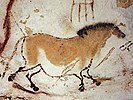




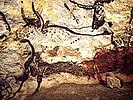

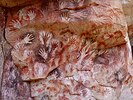
![Gwion Gwion rock paintings found in the north-west Kimberley region of Western Australia c. 15,000 BC[17]](http://upload.wikimedia.org/wikipedia/commons/thumb/4/43/Bradshaw_rock_paintings.jpg/140px-Bradshaw_rock_paintings.jpg)

